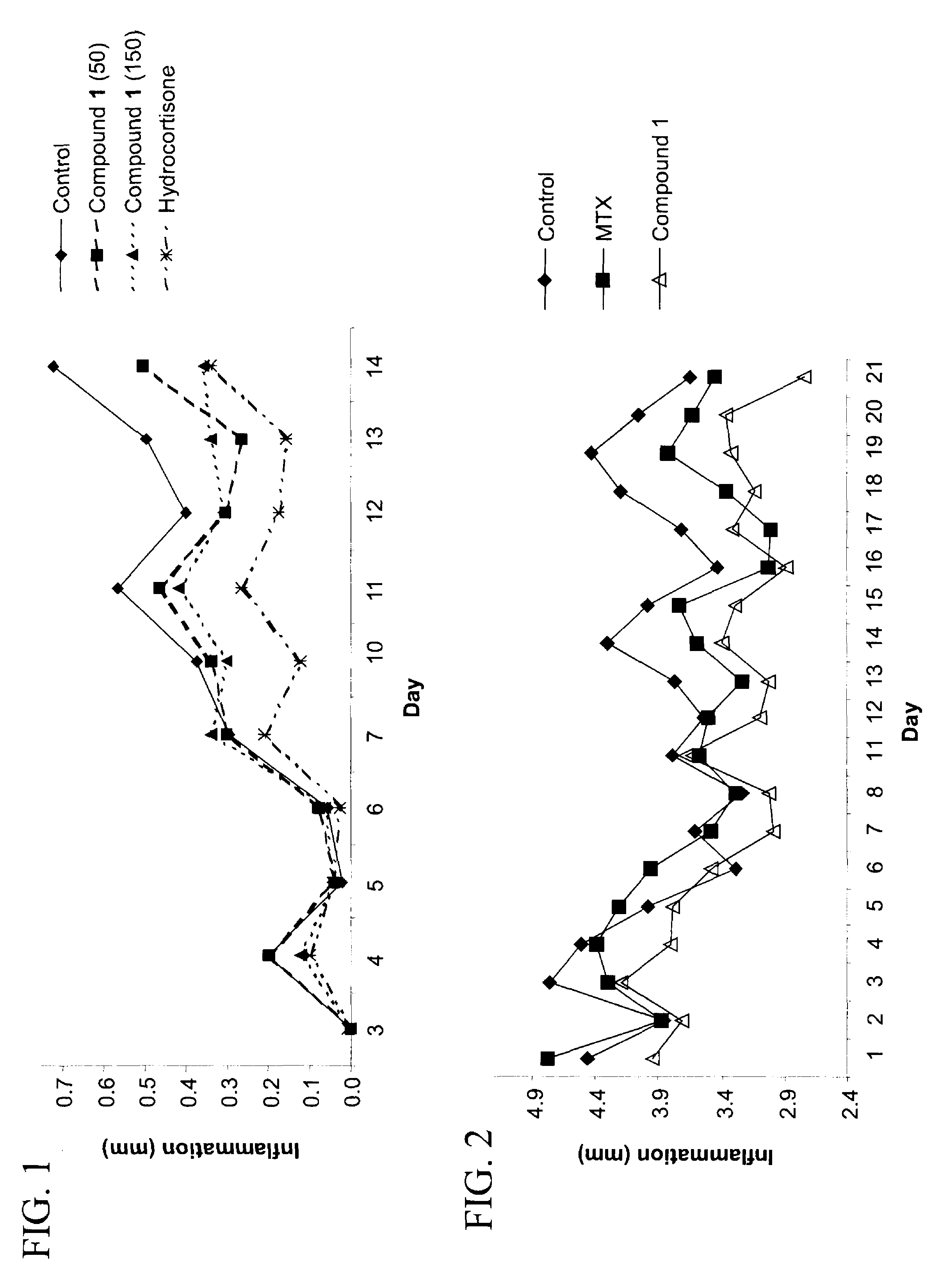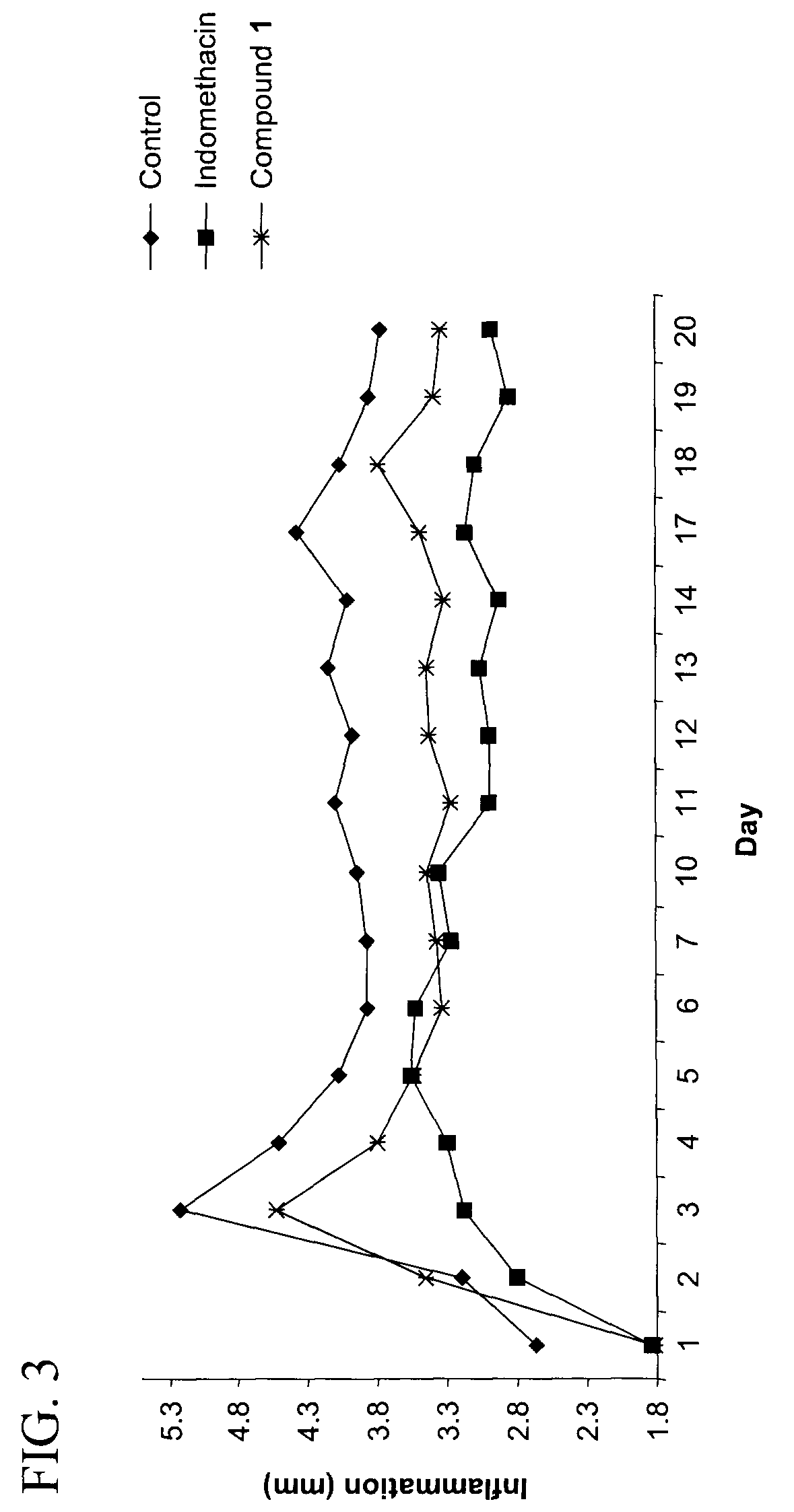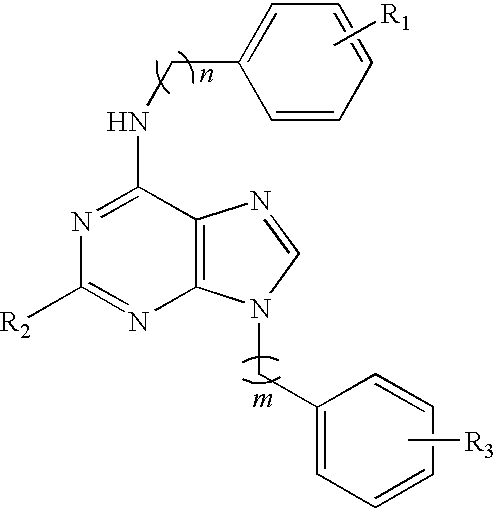Purine derivatives and their use for treatment of autoimmune diseases
a technology of autoimmune diseases and derivatives, which is applied in the direction of immunological disorders, drug compositions, peptides, etc., can solve the problems of inability to meet the needs of patients, so as to facilitate the clearance of immune complexes, reduce the risk of opportunistic infections, and limit the effect of deposition
- Summary
- Abstract
- Description
- Claims
- Application Information
AI Technical Summary
Benefits of technology
Problems solved by technology
Method used
Image
Examples
example 1
(Representative Example of Scheme 1): Synthesis of N-{9-[2-(4-aminophenyl)ethyl]-9H-purin-6-yl}benzene- 1,3-diamine dihydrochloride (compound 1)
[0058]
[0059]To a solution of 4-aminophenethyl alcohol (3.0 g, 21.8 mmol) in tetrahydrofuran (100 mL) at room temperature was added di-tert-butyldicarbonate (5.2 g, 23.6 mmol) and triethylamine (4.7 mL, 32.8 mmol). The reaction was stirred for 16 h at room temperature. The solution was diluted with water (100 mL) and ethyl acetate (100 mL). The aqueous layer was extracted with ethyl acetate (100 mL). The organic layers were dried over sodium sulfate and filtered. The protected amine was obtained as a white solid (4.3 g, 83%). This compound (1.7 g, 7.4 mmol) and triphenylphosphine (1.9 g, 7.4 mmol) were added to a suspension of 6-chloropurine (761 mg, 4.9 mmol) in dry tetrahydrofuran (13 mL) at room temperature. The resulting mixture was evaporated to dryness. Dry tetrahydrofuran (13 mL) was added and the suspension was cooled to 0° C. followe...
example 2
(Representative Example of Scheme 2): Synthesis of N6-(3-Amino-phenyl)-9-[2-(4-amino-phenyl)-ethyl]-N2-cyclopropylmethyl-9H-purine-2,6-diamine (Compound 3)
[0061]
[0062]To 2-amino-6-chloropurine (5.0 g, 29.5 mmol) in a solution of tetrafluoroboric acid in water (100 mL) at −15° C. was added dropwise sodium nitrite (3.5 g, 50 mmol) in water (160 mL) over a period of 1.5 h. After 20 min at room temperature, the pH of the solution was adjusted to 6 with 50% aqueous sodium hydroxide. The solution was concentrated under reduced pressure. The crude residue was purified on a BIOTAGE™ 40S column (silica, CH2Cl2 / MeOH 9:1) to give 2-fluoro-6-chloropurine (2.3 g, 52%). This compound (1.5 g, 8.6 mmol) was suspended in dry tetrahydrofuran (20 mL) at 25° C. The 4-(N-1-tert-butyloxycarbonyl)-aminophenethyl alcohol (3.4 g, 14.5 mmol) and triphenylphosphine (3.8 g, 14.5 mmol) were then added, and the mixture evaporated to dryness. Dry tetrahydrofuran (20 mL) was added and the suspension was cooled to ...
example 3
N6-(3-Amino-phenyl)-9-[2-(4-amino-phenyl)-ethyl]-9H-purine-2,6-diamine (Compound 2)
[0063]The above compound was prepared as in Example 1 starting with 2-amino-6-chloropurine. Brown solid; 1H NMR (400 MHz, CD3OD): δ 7.92 (s, 2H), 7.63 (d, 1H, J=8.8 Hz), 7.46 (t, 1H, J=7.6 Hz), 7.40-7.20 (m, 4H), 7.00 (d, 1H, J=8.2 Hz), 4.44 (t, 2H, J=7.2 Hz), 3.24 (t, 2H, J=6.8 Hz); LRMS (ESI): m / z 361 (MH+), 383 (M+Na); HPLC (method 3): 0.4 min.
PUM
| Property | Measurement | Unit |
|---|---|---|
| temperature | aaaaa | aaaaa |
| insoluble | aaaaa | aaaaa |
| cellular stress | aaaaa | aaaaa |
Abstract
Description
Claims
Application Information
 Login to View More
Login to View More - R&D
- Intellectual Property
- Life Sciences
- Materials
- Tech Scout
- Unparalleled Data Quality
- Higher Quality Content
- 60% Fewer Hallucinations
Browse by: Latest US Patents, China's latest patents, Technical Efficacy Thesaurus, Application Domain, Technology Topic, Popular Technical Reports.
© 2025 PatSnap. All rights reserved.Legal|Privacy policy|Modern Slavery Act Transparency Statement|Sitemap|About US| Contact US: help@patsnap.com



